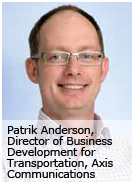INSIGHTS
As cities grow, public transit has boomed as well. Keeping people and assets safe, while keeping threats out, is the goal of transit authorities. Each year, roughly a billion passengers take the London Underground, making it one of the largest transit systems in the world. Across the Atlantic, the New York City subway system carries 1.6 billion passengers annually, while Tokyo’s system serves 3.1 billion. China plans to break ground on 17 rapid transit systems, making public transit a dynamic market. Buses serve even more people, with service in locations where there are no railways. From private minibuses to large coaches, buses offer great reach over large distances. Public transit buses efficiently transport large numbers of passengers, keeping more cars off the road and reducing pollution. However, increased ridership makes public-transit systems high-profile targets. Deliberate acts of terrorism include remotely triggered bombs and suicide bombers.
On the Road with Public Transit Security Ⅰ
Date: 2011/03/08
Source: By a&s International
Open Access
Public transit aims to increase ridership, making disruptions undesirable. Any interruption — accidental or deliberate — could result in mass casualties and damage. While public transportation systems need to be accessible, they must also prevent threats and record evidence for a speedy response. “The nature of public transport is that it is an open transport system where people, passengers and, potentially, offenders can enter directly from the city environment,” said Patrik Anderson, Director of Business Development for Transportation, Axis Communications.
The 7/7 London bombings were coordinated on subway trains and buses at 8:15 a.m., the peak of rush-hour traffic. “If we're talking about terrorist activity, they tend to do it at the least convenient time,” said Udi Segall, Director of Product Marketing, Surveillance Division, Security Group, Nice Systems. As subways and trains are open, transit authorities must consider the purpose for security. While evidence for the post-event investigation is useful, UK investigators had to watch 28,000 cameras to compile seven hours of relevant footage. Effective monitoring requires clear planning.
 Chemical attacks must be accounted for as well in rapid transit, with millions of commuters in a day. The Tokyo sarin gas attack proves the threat is a real one, said Jamie Edgar, Global Director of Integrated Sensor Systems, Smiths Detection. It took more than an hour to understand the problem and direct an organized response; newer systems with sensors aim to quickly identify the substance and where it is dispersed in a matter of five minutes.
Chemical attacks must be accounted for as well in rapid transit, with millions of commuters in a day. The Tokyo sarin gas attack proves the threat is a real one, said Jamie Edgar, Global Director of Integrated Sensor Systems, Smiths Detection. It took more than an hour to understand the problem and direct an organized response; newer systems with sensors aim to quickly identify the substance and where it is dispersed in a matter of five minutes.
Apart from organized attacks, more common problems exact their toll on public-transit systems. Violence or sexual harassment take place on trains and buses, requiring security systems to capture evidence and bring offenders to justice, said Kaz Shimizu, Product Marketing Manager, TOA.
In Canada, the Winnipeg Transit added cameras to its buses. It averaged 30 driver assaults and 50 passenger incidents aboard each year; the cameras were intended to deter more assaults. Vandalism is also a mundane but expensive concern, Segall said.
 Harsher climates, such as Moscow, require unique considerations. About 9 million Muscovites take the metro daily at 173 stations. “Weather and accidents also contribute to the list of situations that can put both efficiency and safety at risk,” said David Fowler, Senior VP of Marketing and Product Development, VidSys.
Harsher climates, such as Moscow, require unique considerations. About 9 million Muscovites take the metro daily at 173 stations. “Weather and accidents also contribute to the list of situations that can put both efficiency and safety at risk,” said David Fowler, Senior VP of Marketing and Product Development, VidSys.
Security operators must clearly delineate their objectives, as security becomes a requirement. “The objective of individual security executives at the various local mass transit facilities as well as the Transportation Security Administration, a sector of the US Department of Homeland Security, is to advance mass transit and passenger rail security through a comprehensive strategic approach that enhances capabilities to detect, deter, prevent and respond to crimes, including terrorist attacks,” said Mark Wilson, VP of Marketing, Infinova. “Their common objective is to first, prevent attacks and security incidents and then respond to and recover from, any incidents that do occur.”